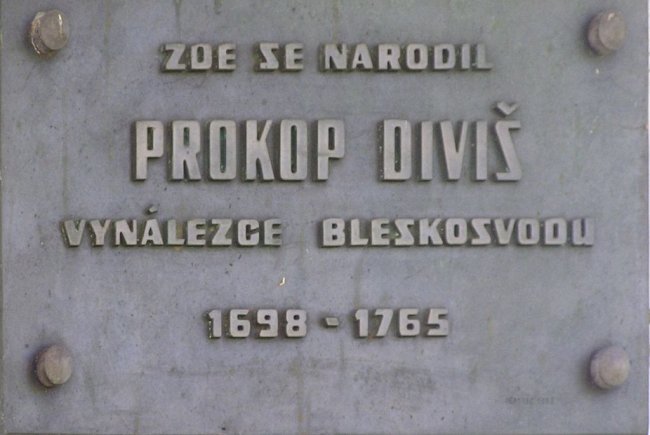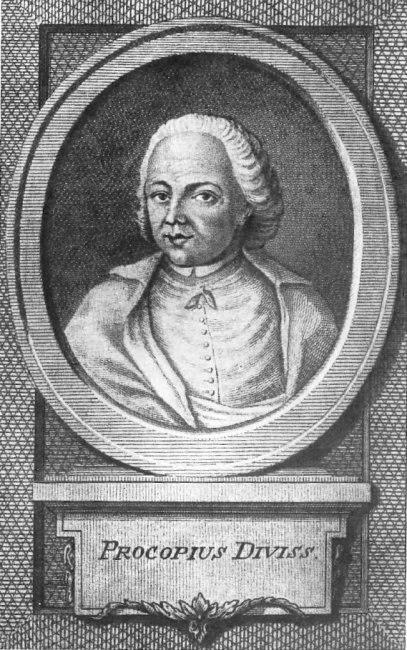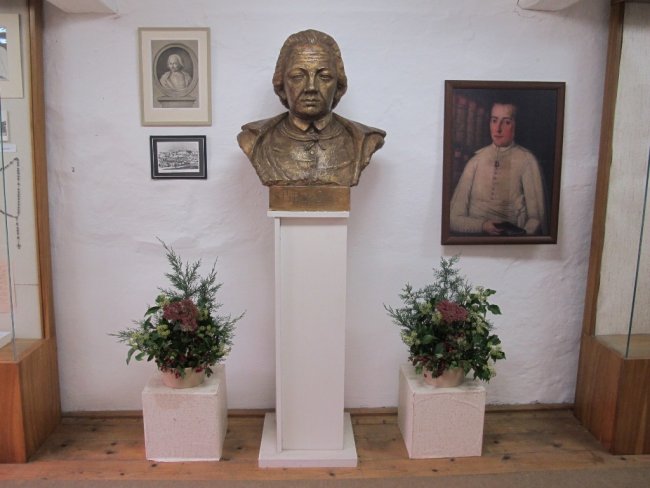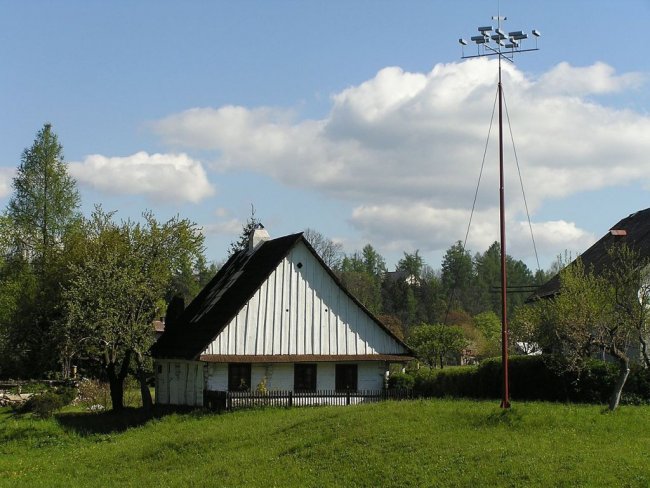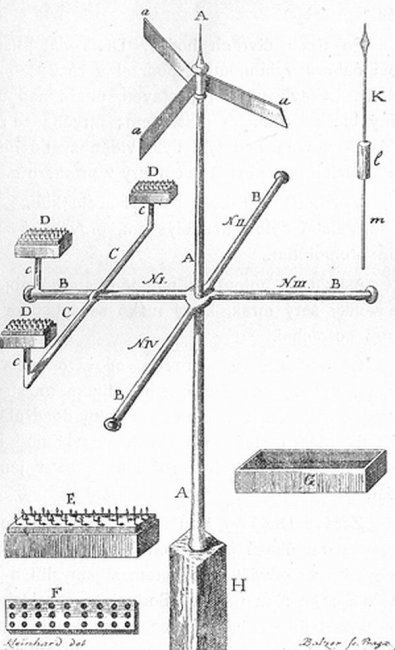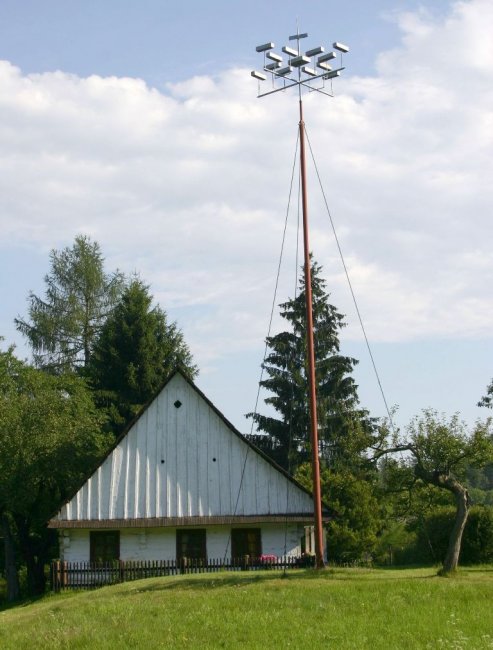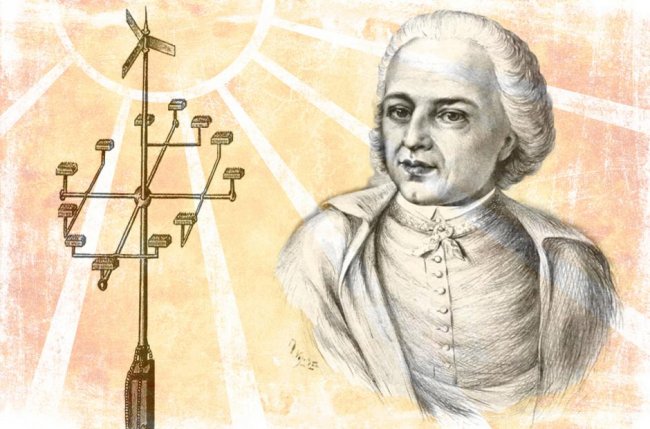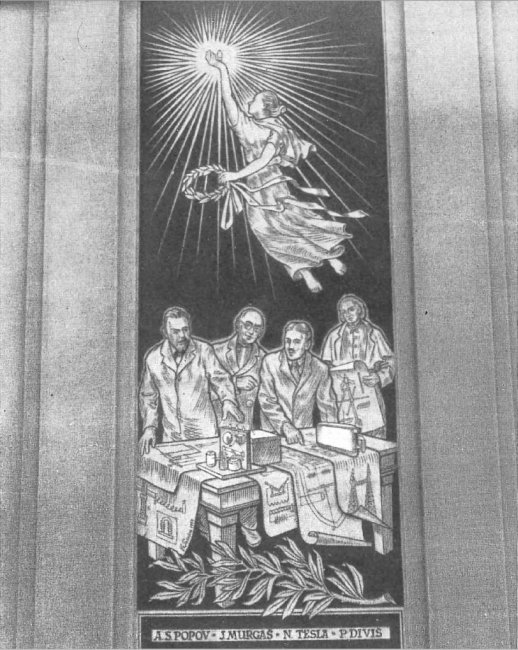The inventor of the first lightning rod, a priest from the Czech Republic, Vaclav Prokop Divish
The famous Czech Catholic priest, theologian, naturalist, healer, musician and inventor Vaclav Prokop Divis was born on March 26, 1698 in Helvikovice near Amberk. He is best known as the inventor of the lightning rod.
He built his "weather machine", which functions as a lightning rod, in 1754, earlier than the world-famous lightning rod inventor Benjamin Franklin… However, Divish's concept was different from Franklin's, his lightning rod was grounded and therefore worked better.
In 1720, Divish, after graduating from high school, entered the Order of Demonstrators in Luka near Znojmo as a novice. In September 1726, he was ordained a priest. He also became a science teacher. In 1729 he was appointed professor of philosophy and theology.
Birthplace plaque of Vaclav Prokop Divis
During his teaching career, he defended a thesis in the field of theology and philosophy. In 1733 he successfully defended his work and received a doctorate in theology in Salzburg and a doctorate in philosophy in Olomouc.After graduating from Salzburg, he was appointed patron of the monastery in Lucca.
In 1753 Vaclav Prokop Divis (an excellent musician himself) used electricity to make his musical instrument. He created the unique Denis d'Or stringed instrument. The electricity was supposed to clean up the sound of the strings.
This unique device had 790 metal strings, 3 keyboards, a 3-pedal system and was connected to Leyden banks. However, the instrument has not survived to this day. This invention is currently under consideration one of the first electric musical instruments in history.
V.P.Divish also used static electricity for medical purposes, observing its beneficial effects in the treatment of various forms of paralysis, rheumatism and muscle spasms.
Prokop Divish. Portrait of an unknown artist from the 18th century. From F. Pelzel's book «Abbildungen».
In the middle of the 18th century. experiments with electricity were widespread which soon led to the idea that lightning It's just an analogy with an electric spark. It is often demonstrated in ongoing experiments. In society, experiments with electricity have become a very fashionable attraction.
Divish also took up electricity: already in 1748 he experimented with it. If we consider the fact that the strings of his musical instrument «Denidor» are electrified, then we can determine that he was experimenting with electricity when this musical instrument was already made. It is possible that his long-standing interest in music led Divis through Denidore to experiments with electricity.
His experimental technique was at the level of that time.In experiments with electricity, two devices played the main role: an electric friction machine and a Leyden bank. Experiments with the use of the Diviš Leyden jar probably began in 1746.
He relied on knowledge of the phenomena of electrostatics, experimenting mainly with the attraction and repulsion of the same name with oppositely charged objects. Knowing this phenomenon, a trick was constructed, which he called the figure of Vulcan, consisting of the figure hitting an iron wire with an iron hammer and electric discharges occur.
The tricks with the electric discharge demonstration looked very impressive, and Divish managed to get discharges up to 20 cm long. With an electric spark, he pierced paper and wood, ignited highly flammable liquids.
Divish often demonstrates light phenomena when sparks fall from charged metal points. He showed how an electrified liquid flows from a vessel, how metal points attract each other, subtly removing an electric charge from the surface of the ball of an electric friction machine.
With this focus, he repeatedly spoke in the Viennese palace of Count Wallenstein, before Duke Franz Stephen of Lorraine—Emperor Franz I.
Divish Museum in the Czech Republic
In the summer of 1753, a message came from St. Petersburg that on July 26, when he was conducting experiments with atmospheric electricity, lightning killed Academician G. V. Richman. It was probably a ball. Divish responded to Richman's tragic death primarily by intensifying his theoretical research on electricity.
He decided to install in s. Premetice «weather machine». In doing so, he proceeds from the ability of metal points to "suck" electricity from the atmosphere.
In general, Divish first mentioned his plan to install a "lightning rod" in a letter to L. Euler dated October 24, 1753. He realized it when he installed his "meteorological machine" on June 15, 1754.
Observations have begun. On August 17, 1757, Divish wrote to Euler that under her influence thunder clouds in the vicinity of the village. The item is always scattered. There are two descriptions of "meteorological lightning" and both are reliable historical records.
The first belongs to Divish himself and was made in 1761. It was accompanied by a drawing, which, however, has not survived. The second description, together with the drawing, was published by the biographer Divish Pelzl in 1777. The description of this protective device is given among the descriptions of other lightning rods.
Divish's "lightning rod" was generally a grounded device and fully fulfilled the function assigned to it by the author, but it was fundamentally different from what a lightning rod actually is.
House of Vaclav Prokop Divis in Amberk
Divish has technically realized his ideas about the suction action of metal points. He was convinced that his device "sucked" the electric charge out of the atmosphere and thus prevented not only the occurrence of lightning, but also thunderstorms in general. His device was not designed to protect tall objects from lightning, but by "sucking" an electric charge from the atmosphere it was supposed to create fair weather.
This "weather machine" feature explains why this device has such a large number of metal points. It was believed that Davis's "weather machine" was never struck by lightning.
Lightning rod diagram
In 1759, there was heat in the vicinity of Znojmo, which caused a bad harvest in the fields of the village of Parshintse.Parishioners associate drought and poor harvests with the workings of the "weather machine". According to them, the lightning rod, "sucking" electricity from the atmosphere, contributed to the spread of good dry weather.
It is known from the records of Divis himself that the parishioners demanded the removal of the «weather machine». In response to this request, the monastic authorities ordered that she be transferred to Lucca.
The next year was very wet, but again a poor crop. In Divish's notes we read that the grain and grapes would yield a good harvest if his "weather machine" had its effect. According to reports by many authors, parishioners requested Divis. to reinstall your device.
It is known from reliable sources that Divish installed two "weather machines" in Przymetica: the first in 1754, the second, probably in 1760. In his letter to his friend Fricker Divish wrote that a second "meteorological machine" was installed at the tower of the church in Przymitsa with the consent of the bishop's consistory in Olomouc.
Reconstruction of the Diviš lightning rod in Znojmo
On September 5, 1753, he informed L. Euler at the Berlin Academy of Sciences and presented his study "Microscopic Thunderstorm". This is one of the signs of Divish's interest in atmospheric electricity.
On October 24, Divish again wrote to Berlin and explained the reasons for Richman's death in St. Petersburg. According to him, Richman made one moral and two physical mistakes.
His moral mistake was that he put himself in danger knowing that he could die during experiments, Riechmann's first physical mistake was that he wanted to see a "fiery or electric discharge" in daylight, which is only possible through the night, the second — he placed at the end of the conclusion a glass vessel with iron filings, that is, his own "electrical fluid," whose "elemental fire" increases during a thunderstorm and is difficult to extract.
Divish thus explains Richman's death on the basis of his theory of electric and elemental fire. It is not clear from his explanation whether he realized the need to ground the lightning rod.
In July 1755, through the Russian ambassador in Vienna, he sent his treatise on "electric fire" to St. Petersburg. He reached his destination only 13 months later, in August 1756. In this letter to the St. Petersburg Academy, Divish presented his theory of electricity and lightning, but wrote mainly about electrotherapy.
He participated in the competition announced by the St. Petersburg Academy on the topic "On the essence of electricity". And although he was not awarded a prize, his contribution to science was appreciated by L. Euler in a work published by the Petersburg Academy in 1768.
A positive assessment of Divisch's experiments with atmospheric electricity is given in Euler's popular science encyclopedia "Letters to a German Princess on Various Physical and Philosophical Subjects".
Inventor of the first lightning rod
In the last part of the second volume, the problems with electricity are considered, where Euler writes: "At one time I corresponded with a Moravian priest, Procopius Divis, who assured me that during the whole summer he diverted all thunderstorms from the village where he lived and its surroundings , using a device manufactured in accordance with the basic laws of electricity. «
He also mentions the Richman case. Euler is convinced of the correctness of the thought of the "Moravian priest" that an electric charge can be taken from the clouds and carried to the ground without discharge.
After all, the protective system proposed by Euler is essentially the Divisch system: metal pointed rods attached to high objects and connected by conductive circuits to the ground. According to the addition of Euler himself, the circuits must pass underground even to rivers, lakes and ponds.
In the last years of his life, Divish worked on a work in which he wanted to summarize the results of his experiments with electricity. He completed this work, but could not publish it, difficulties arose with church censorship. A few years later he received permission to publish the work outside of Austria-Hungary.
Divisch's work, entitled Magia naturalise, was first published in 1765 in Tübingen, and the second in 1768 in Frankfurt am Main. It was translated into German from the Latin by Fricker, a pupil of Ettinger, who also contributed to the publication of this work. The caption below the title reads: "A long-needed theory of meteorological electricity."
Magia naturalise consists of 3 chapters and 45 paragraphs. The introductory part is devoted to the ethereal theory of electricity by Johann A. Euler (the eldest son of L. Euler).
At the beginning of the book, Divish assesses the current level of knowledge about electricity, the science of electricity as "the most beautiful and fundamental science", "... because if you study the whole philosophy of Aristotle, the systems of Leibniz and Newton, it will become obvious that no one is did this, there are many surprising and useful discoveries, as the emerging science of electricity is making them today. «
"Earth", "water", "air" and "fire" were for him the basic physical concepts, and the "science of electricity", that is, of fire, was to become the basis of physics. He rated it higher than Aristotle's physics , but he does not oppose them dialectically, but considers the science of electricity as a qualitatively higher stage in the development of Aristotle's physics.
Divish goes into detail about how thunderstorms happen, and also describes his famous trick with the glow of electrified vacuum glass tubes partially filled with mercury.
Image of electrologists of Slavic origin (Popov, Murgash, Tesla and Divish) on the building of the Tesla power plant in Roznov pod Radoshtyu (Czechoslovakia). Photo from 1963.
Vaclav Prokop Divish is an experienced experimenter, his "meteorological machine" is a perfect constructive solution, the first implementation of the idea of the possibility of protecting high objects from lightning.
It was created and installed at the time when, after the tragic death of St. Petersburg Academician Richman, most physicists stopped experimenting with atmospheric electricity.
From this point of view, the Divis machine is a bold expression of belief in the power of scientific knowledge and the possibilities of its application for the benefit of man.
In reasoning about the action of the lightning rod, Divish starts from the idea of a trap tip, which supposedly neutralizes the charge of the clouds with a "quiet tip discharge".
According to modern concepts of atmospheric electricity, this view is wrong, since the task of a lightning rod is not to prevent lightning, but to divert its charge to the Earth as far as possible without damage.
Divish's theoretical ideas found a lively response from a group of scientists, but were not continued in the further development of physics.
While Franklin's lightning rod is widely known, and the tombstone of its inventors is carved with the inscription: "He took the lightning from the heavens and the scepter from the tyrants," we do not even know about Divish whether he died on December 21 or 25, 1765, and where he was buried.

